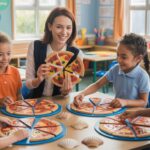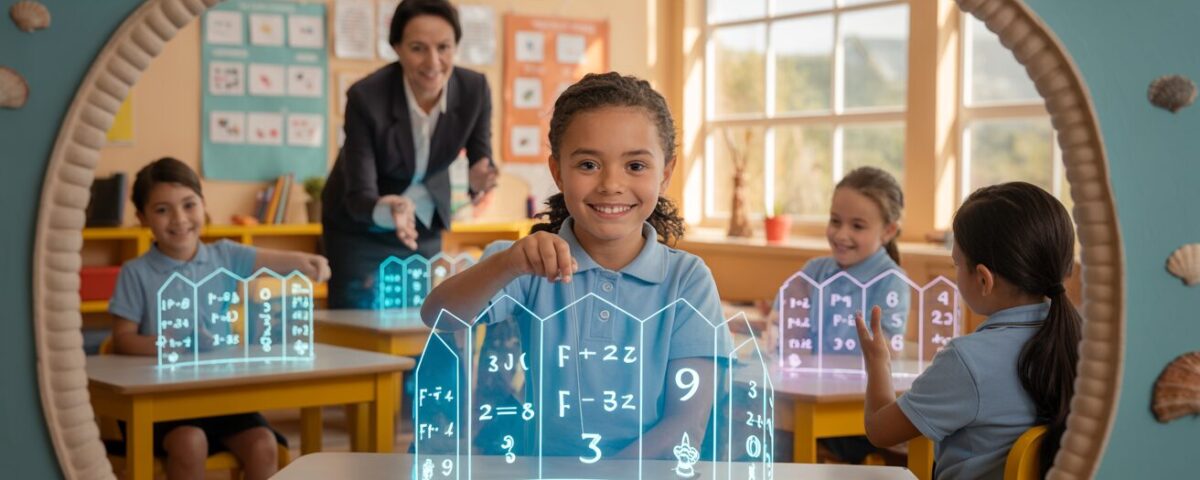
Parent’s Comprehensive Checklist for Choosing the Best Chinese Tuition Centre in Singapore
October 18, 2025
DIY Fraction Pizza Lesson: Making Math Deliciously Educational for Primary Students
October 19, 2025Table Of Contents
- Introduction
- Common Memory Challenges for P3-P6 Math Students
- The Math Memory Palace Technique
- Visual Association Techniques
- Storytelling and Narrative Methods
- Movement and Kinesthetic Learning
- Gamification Strategies for Math Facts
- The Seashell Method: Combining Techniques for Optimal Results
- Practical Implementation Tips for Parents
- Conclusion
Is your child struggling to recall multiplication tables during math tests? Do fraction conversions cause anxiety? Are mathematical formulas becoming a source of frustration rather than fascination? For P3-P6 students in Singapore, mastering essential math facts isn’t just about academic success—it’s about building a solid foundation for future learning while maintaining a healthy relationship with mathematics.
At Seashell Academy by Suntown Education Centre, we understand that memorization is only effective when it’s both engaging and emotionally supportive. That’s why we’ve developed creative memory techniques that transform the traditional rote learning experience into something magical—quite literally, in the case of the memory palace technique!
This comprehensive guide will explore how innovative memorization strategies like the memory palace technique can help your child not only remember math facts but genuinely understand and enjoy mathematics. We’ll share practical, age-appropriate techniques specifically designed for P3-P6 students that build both competence and confidence—techniques you can start implementing immediately at home to support your child’s mathematical journey.
Common Memory Challenges for P3-P6 Math Students
Before diving into solutions, it’s important to understand the specific memory challenges P3-P6 students face with mathematics. During these crucial primary school years, the math curriculum expands significantly:
In Primary 3, students begin tackling multiplication and division, working with numbers up to 10,000, and exploring fractions and time concepts. By Primary 6, they’re expected to master percentages, ratios, circles, volume, and statistics—all while preparing for the high-stakes PSLE examination.
The memory challenges at this stage typically include:
Volume of information: The sheer amount of math facts to remember increases dramatically between P3 and P6, from basic multiplication tables to complex formulas and procedures.
Abstract concepts: Mathematics becomes increasingly abstract, making it difficult to connect memorized facts with tangible understanding.
Test anxiety: As examination pressure grows, many students experience anxiety that blocks memory recall, especially during time-constrained tests.
Disconnected learning: Traditional memorization often fails to connect new information to existing knowledge, resulting in isolated facts rather than an integrated understanding.
This is where creative memory techniques become invaluable—not as shortcuts, but as bridges connecting memorization with understanding and confidence.
The Math Memory Palace Technique
The memory palace (also known as the method of loci) is a powerful mnemonic strategy that has been used since ancient times. This technique harnesses the brain’s exceptional spatial memory capabilities and applies them to abstract information like math facts. Research has shown that spatial memory techniques can increase retention by up to 50% compared to standard memorization methods.
How It Works
The memory palace technique works by visualizing a familiar physical location—like your home, school, or favorite park—and placing information you want to remember at specific locations within that space. When you need to recall the information, you simply take a mental journey through your “palace” and encounter each fact where you placed it.
This approach is particularly effective because it:
Utilizes spatial memory: Our brains evolved with exceptional spatial navigation abilities, making location-based memory extremely powerful.
Creates strong associations: By linking abstract math concepts to concrete locations, students form stronger neural connections.
Reduces anxiety: The technique transforms memory recall from a stressful task into an imaginative journey, reducing test anxiety.
Engages multiple senses: By creating vivid mental images that incorporate sight, sound, and even smell, memory becomes multi-sensory and more robust.
Implementing the Memory Palace for Math Facts
Here’s how P3-P6 students can create their own math memory palace:
Step 1: Choose a familiar location – Select a place your child knows well—typically your home is ideal. The location should have multiple distinct areas (rooms, furniture, notable features).
Step 2: Define a clear path – Create a specific route through this location that follows a logical sequence, such as moving from the front door through each room of the house.
Step 3: Assign math facts to specific locations – Place each math fact at a specific point along the route. For multiplication tables, for example, each product could be represented by a specific piece of furniture or feature.
Step 4: Create vivid associations – The more unusual, colorful, or emotionally engaging the mental image, the easier it will be to remember. For instance, to remember that 7 × 8 = 56, a child might imagine 56 colorful balloons floating above the living room sofa.
Step 5: Practice the journey regularly – Have your child mentally walk through their memory palace regularly, retrieving each fact as they encounter its location.
A Primary 4 student preparing for a multiplication test might create a memory palace where:
• The front door has 12 bright yellow sunflowers (representing 3 × 4 = 12)
• The shoe rack holds 28 pairs of dancing shoes (representing 7 × 4 = 28)
• The kitchen table has 36 cupcakes arranged in rows of 4 and columns of 9 (representing 4 × 9 = 36)
At Seashell Academy by Suntown Education Centre, we guide students in creating personalized memory palaces that align with their learning styles and interests, making mathematics both memorable and enjoyable.
Visual Association Techniques
While the memory palace is one visual technique, there are many other visual association strategies that work exceptionally well for math facts. These approaches are particularly effective for P3-P6 students who have strong visual learning preferences.
Number-Picture Associations – This technique involves creating a consistent image that represents each number. For example, 1 might be a pencil, 2 a swan, 3 a tripod, etc. When memorizing math facts, students combine these images in creative ways. To remember 3 × 4 = 12, they might visualize a tripod (3) taking photos of a chair (4), producing an album with 12 pictures.
Color Coding – Assigning consistent colors to numbers can create powerful visual patterns that enhance memory. For example, even numbers could be blue while odd numbers are red. Multiplication by 5 could always be represented in green. These color associations create visual patterns that make recall easier.
Mind Mapping – Creating visual mind maps that connect related math concepts helps students see the relationships between different facts. For example, a mind map for fractions might connect equivalent fractions, showing visually how 1/2 relates to 2/4, 3/6, and 4/8.
One particularly effective technique we use at Seashell Academy’s Mathematics Programme is the “Math Comic Strip” method, where students create simple four-panel comic strips to illustrate mathematical relationships. This technique has been shown to increase retention by up to 65% compared to standard practice sheets, while simultaneously making the learning process more enjoyable.
Storytelling and Narrative Methods
Humans are natural storytellers—our brains are wired to remember narratives better than isolated facts. By transforming math facts into engaging stories, P3-P6 students can dramatically improve their recall while developing deeper conceptual understanding.
Number Characters – Create distinctive personalities for different numbers. For instance, “Seven” might be adventurous and always climbing, while “Eight” could be balanced and symmetrical. When these characters interact in stories, they create memorable math facts. “Seven climbed up Eight’s perfectly balanced shoulders, and together they reached 56!”
Math Adventures – Develop ongoing stories where the characters encounter mathematical challenges. A series of connected stories can cover an entire topic, such as fractions or geometry, with each episode reinforcing key concepts.
Personal Connection Stories – Help students connect math facts to personal experiences. If a student loves football, the fact that 7 × 9 = 63 could become a story about scoring 7 goals in 9 different matches, totaling 63 amazing goals for the season.
In our Programme Philosophy at Seashell Academy, we emphasize that learning should be meaningful and connected to students’ lives. Storytelling creates these connections naturally, transforming abstract concepts into meaningful experiences.
Movement and Kinesthetic Learning
Physical movement powerfully enhances memory, especially for kinesthetic learners. By incorporating body movement into math practice, students can create muscle memory that supports cognitive recall.
Math Dance Patterns – Create simple choreographed movements that represent different math operations or facts. For multiplication tables, specific hand movements or steps can be associated with each number and operation. Dancing through the 9 times table creates both muscle memory and joy.
Rhythm and Chants – Set math facts to rhythms that students can clap, tap, or move to. “THREE times EIGHT is TWEN-ty FOUR” has a natural rhythm that can be enhanced with movement. These rhythmic patterns become internalized, making recall almost automatic.
Math Tag and Active Games – Transform traditional tag games by incorporating math challenges. When tagged, students must answer a math fact before rejoining the game. This connects physical exhilaration with mathematical thinking.
One of our favorite techniques at Seashell Academy involves creating “Math Pathways” where students physically walk through mathematical processes. For example, when learning long division, students might move through physical stations representing each step of the algorithm, physically carrying numbers from one place to another.
This approach not only improves memory but transforms abstract procedures into concrete experiences—a key aspect of our approach to building sustainable learning that doesn’t lead to burnout.
Gamification Strategies for Math Facts
Gamification harnesses the motivational power of games to make learning more engaging and effective. For P3-P6 students, math fact games provide repeated practice without the tedium of traditional drills.
Math Fact Card Games – Adapt familiar card games to practice math facts. A modified version of “Go Fish” might have students asking, “Do you have a card that multiplies with mine to make 36?” These games provide repeated practice in a social, low-stress context.
Math Fact Challenges – Create friendly competitions where students “level up” as they master different sets of math facts. Visual progress trackers, such as climbing a mountain or completing a treasure map, provide motivation and a sense of accomplishment.
Digital Math Games – Carefully selected digital games can provide engaging practice. Look for games that adapt to your child’s level, provide immediate feedback, and make mathematical thinking explicit rather than just drilling facts.
At Seashell Academy, we’ve developed the “Math Quest” system where students embark on mathematical adventures, earning “wisdom pearls” as they master different concepts and facts. This approach aligns with our seashell metaphor—each math fact is like a pearl forming within the protective environment of supportive learning.
The Seashell Method: Combining Techniques for Optimal Results
While each memory technique is effective, the most powerful approach combines multiple methods to address different learning styles and create multiple memory pathways. At Seashell Academy by Suntown Education Centre, we’ve developed the Seashell Method that integrates these approaches in a structured yet flexible framework.
The Seashell Method consists of five interconnected elements:
Structure – Creating organized frameworks (like memory palaces) that provide a scaffold for new information
Emotion – Incorporating positive emotional connections through storytelling and personal relevance
Association – Building strong links between new math facts and existing knowledge
Sensing – Engaging multiple senses through visualization, movement, and verbal rehearsal
Habit – Developing consistent practice routines that build long-term retention
This integrated approach ensures that math facts aren’t just memorized temporarily but become part of a child’s permanent mathematical understanding. The Seashell Method nurtures both academic excellence and emotional well-being—creating confident, capable math students who approach challenges with resilience.
Our P4 Chinese Programme, P5 Chinese Programme, and P6 Chinese Programme all use similar principles, demonstrating how these memory techniques can be applied across subjects.
Practical Implementation Tips for Parents
Supporting your child’s use of these memory techniques at home can significantly enhance their effectiveness. Here are practical tips for parents:
Start Small – Begin with a limited set of math facts using one technique. For example, create a mini memory palace with just the 6, 7, and 8 times tables before expanding.
Respect Your Child’s Learning Style – Pay attention to which techniques resonate most with your child. Some children naturally gravitate toward visual methods, while others prefer movement or storytelling.
Make It Playful – Keep the atmosphere light and exploratory. These techniques should feel like creative play rather than another form of drilling.
Be Consistent – Schedule regular short practice sessions (10-15 minutes) rather than occasional long sessions. Consistency builds stronger neural pathways.
Celebrate Progress – Acknowledge improvements in both memory and confidence. Celebrating small wins builds momentum and positive associations with mathematics.
Connect With School Learning – Ask your child’s teacher which specific math facts they’re focusing on, then target your home practice to reinforce these concepts.
Model Memory Strategies – Share how you use memory techniques in your own life. When children see adults using these strategies, they value them more.
Remember that the goal isn’t just memorization—it’s building a positive, confident relationship with mathematics. These techniques help transform math from a source of anxiety to an opportunity for creative thinking and accomplishment.
Conclusion
The journey of mastering math facts doesn’t have to be tedious or anxiety-inducing. Through creative memory techniques like the math memory palace, visual associations, storytelling, movement, and gamification, P3-P6 students can develop both exceptional recall and genuine understanding.
At Seashell Academy by Suntown Education Centre, we believe that true learning happens when academic rigor is paired with emotional well-being and engagement. Our Seashell Method embodies this philosophy, nurturing students like pearls forming within a supportive environment—developing gradually but magnificently, layer by layer.
The memory techniques shared in this guide do more than help students pass tests; they build confidence, creativity, and a lifelong positive relationship with mathematics. They transform math facts from isolated bits of information into connected, meaningful knowledge that students can apply creatively in various contexts.
Whether your child is preparing for P3 math concepts, tackling the complexities of P5 fractions, or reviewing for the PSLE, these memory techniques provide valuable tools that extend far beyond examinations. They build learning skills that will serve them throughout their educational journey and beyond.
Start small, be consistent, and watch as your child’s mathematical confidence grows alongside their knowledge—not just memorizing facts, but truly mastering mathematics.
Want to learn more about how the Seashell Method can transform your child’s relationship with mathematics? Discover our specialized Mathematics Programme designed specifically for P3-P6 students, or contact us to arrange a consultation with our experienced MOE-trained educators. At Seashell Academy by Suntown Education Centre, we’re committed to nurturing confident, capable learners who develop a genuine love for learning that extends far beyond examinations.





